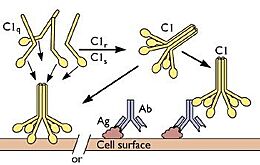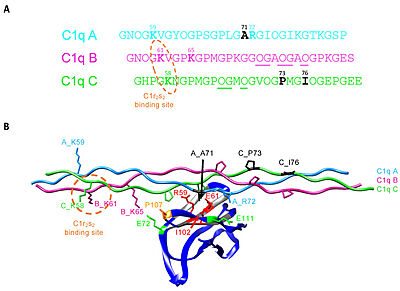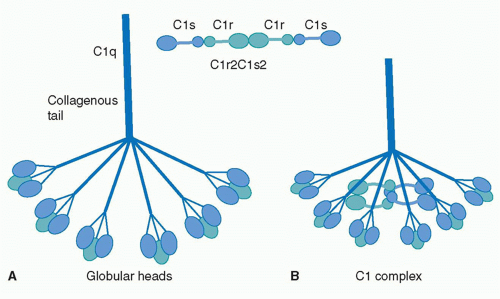User:Matthew Chien/Sandbox 1
From Proteopedia
(Difference between revisions)
| Line 20: | Line 20: | ||
=== Globular Head === | === Globular Head === | ||
| - | C1q is observed to have many active sites depending on what it is interacting with, with most of these active sites being located on the globular head regions. The most researched interaction concerning C1q active site is its interaction with the antibody-antigen complex. C1q largely depends on ionic residues to create salt bridges and ionic bonds with the Cγ2 domain of IgG or the Cμ3 domain of IgM. The Cγ2 of IgG is located on the Fc region, which becomes aggregated upon complexing with antigens, allowing for increased affinity to C1q. <scene name='10/1078778/Gc1q_active_site_1/1'>Residues</scene> Glu198 -X- Asp200 -X- Lys202 on the A chain of the C1q globular head have been shown to be a consistent active site motif on C1q. This region forms an <scene name='10/1078778/Anti-parallel_beta_sheet/1'>antiparallel ß-sheet</scene>, promoting stability. Another active site has been observed on the B chain of the globular head region (ghB) at <scene name='10/1078778/114_129_c1q_active_site/1'>residues</scene> 114-129. The principle residues involved in binding are the Arg114 and Arg129. These residues interact with charged residues on IgG, mostly Lys and Glu. A common motif seen on IgG that these active sites interact with is Glu - X - Lys - X - Lys, located at <scene name='10/1078778/Igg_binding_site/2'>residues</scene> 318, 320, and 322 respectively. This is a common motif seen on many proteins associated with the immune system, which enforces the observation that C1q can interact with many different proteins in many different contexts. One study showed that an arginine or lysine is required at positions 320 and 322 and a glutamic acid or threonine is required at position 318 in order for C1q to successfully bind. This suggests that a hydrogen bond at position 318 and an ionic interaction at positions 320 and 322 are required for C1q to bind to IgG and other epitopes. <ref>PMID:8486696</ref><ref>PMID:3258649</ref> | + | C1q is observed to have many active sites depending on what it is interacting with, with most of these active sites being located on the globular head regions. The most researched interaction concerning C1q active site is its interaction with the antibody-antigen complex. C1q largely depends on ionic residues to create salt bridges and ionic bonds with the Cγ2 domain of IgG or the Cμ3 domain of IgM. The Cγ2 of IgG is located on the Fc region, which becomes aggregated upon complexing with antigens, allowing for increased affinity to C1q. <scene name='10/1078778/Gc1q_active_site_1/1'>Residues</scene> Glu198 -X- Asp200 -X- Lys202 on the A chain of the C1q globular head have been shown to be a consistent active site motif on C1q. This region forms an <scene name='10/1078778/Anti-parallel_beta_sheet/1'>antiparallel ß-sheet</scene>, promoting stability. Another active site has been observed on the B chain of the globular head region (ghB) at <scene name='10/1078778/114_129_c1q_active_site/1'>residues</scene> 114-129. The principle residues involved in binding are the Arg114 and Arg129. These active site residues interact with charged residues on IgG, mostly Lys and Glu/Asp. A common motif seen on IgG that these active sites interact with is Glu - X - Lys - X - Lys, located at <scene name='10/1078778/Igg_binding_site/2'>residues</scene> 318, 320, and 322 respectively. This is a common motif seen on many proteins associated with the immune system, which enforces the observation that C1q can interact with many different proteins in many different contexts. One study showed that an arginine or lysine is required at positions 320 and 322 and a glutamic acid or threonine is required at position 318 in order for C1q to successfully bind. This suggests that a hydrogen bond at position 318 and an ionic interaction at positions 320 and 322 are required for C1q to bind to IgG and other epitopes. <ref>PMID:8486696</ref><ref>PMID:3258649</ref> |
=== Collagen-Like Region === | === Collagen-Like Region === | ||
Revision as of 13:46, 29 April 2025
| |||||||||||
References
- ↑ Reid KBM. Complement Component C1q: Historical Perspective of a Functionally Versatile, and Structurally Unusual, Serum Protein. Front Immunol. 2018 Apr 10;9:764. PMID:29692784 doi:10.3389/fimmu.2018.00764
- ↑ Janeway CA Jr, Travers P, Walport M, et al. Immunobiology: The Immune System in Health and Disease. 5th edition. New York: Garland Science; 2001. The complement system and innate immunity. Available from: https://www.ncbi.nlm.nih.gov/books/NBK27100/
- ↑ Kishore U, Ghai R, Greenhough TJ, Shrive AK, Bonifati DM, Gadjeva MG, Waters P, Kojouharova MS, Chakraborty T, Agrawal A. Structural and functional anatomy of the globular domain of complement protein C1q. Immunol Lett. 2004 Sep;95(2):113-28. PMID:15388251 doi:10.1016/j.imlet.2004.06.015
- ↑ Kaul M, Loos M. Dissection of C1q capability of interacting with IgG. Time-dependent formation of a tight and only partly reversible association. J Biol Chem. 1997 Dec 26;272(52):33234-44. PMID:9407113 doi:10.1074/jbc.272.52.33234
- ↑ Mortensen SA, Sander B, Jensen RK, Pedersen JS, Golas MM, Jensenius JC, Hansen AG, Thiel S, Andersen GR. Structure and activation of C1, the complex initiating the classical pathway of the complement cascade. Proc Natl Acad Sci U S A. 2017 Jan 31;114(5):986-991. PMID:28104818 doi:10.1073/pnas.1616998114
- ↑ Sontheimer RD, Racila E, Racila DM. C1q: its functions within the innate and adaptive immune responses and its role in lupus autoimmunity. J Invest Dermatol. 2005 Jul;125(1):14-23. PMID:15982298 doi:10.1111/j.0022-202X.2005.23673.x
- ↑ Dunkelberger JR, Song WC. Complement and its role in innate and adaptive immune responses. Cell Res. 2010 Jan;20(1):34-50. PMID:20010915 doi:10.1038/cr.2009.139
- ↑ Marqués G, Antón LC, Barrio E, Sánchez A, Ruiz S, Gavilanes F, Vivanco F. Arginine residues of the globular regions of human C1q involved in the interaction with immunoglobulin G. J Biol Chem. 1993 May 15;268(14):10393-402 PMID:8486696
- ↑ Duncan AR, Winter G. The binding site for C1q on IgG. Nature. 1988 Apr 21;332(6166):738-40. PMID:3258649 doi:10.1038/332738a0
- ↑ Almitairi JOM, Venkatraman Girija U, Furze CM, Simpson-Gray X, Badakshi F, Marshall JE, Schwaeble WJ, Mitchell DA, Moody PCE, Wallis R. Structure of the C1r-C1s interaction of the C1 complex of complement activation. Proc Natl Acad Sci U S A. 2018 Jan 8. pii: 1718709115. doi:, 10.1073/pnas.1718709115. PMID:29311313 doi:http://dx.doi.org/10.1073/pnas.1718709115
- ↑ Venkatraman Girija U, Gingras AR, Marshall JE, Panchal R, Sheikh MA, Gal P, Schwaeble WJ, Mitchell DA, Moody PC, Wallis R. Structural basis of the C1q/C1s interaction and its central role in assembly of the C1 complex of complement activation. Proc Natl Acad Sci U S A. 2013 Aug 20;110(34):13916-20. doi:, 10.1073/pnas.1311113110. Epub 2013 Aug 6. PMID:23922389 doi:10.1073/pnas.1311113110
- ↑ Guan EN, Burgess WH, Robinson SL, Goodman EB, McTigue KJ, Tenner AJ. Phagocytic cell molecules that bind the collagen-like region of C1q. Involvement in the C1q-mediated enhancement of phagocytosis. J Biol Chem. 1991 Oct 25;266(30):20345-55 PMID:1939090
- ↑ Fouët G, Bally I, Chouquet A, Reiser JB, Thielens NM, Gaboriaud C, Rossi V. Molecular Basis of Complement C1q Collagen-Like Region Interaction with the Immunoglobulin-Like Receptor LAIR-1. Int J Mol Sci. 2021 May 12;22(10):5125. PMID:34066122 doi:10.3390/ijms22105125
- ↑ Mahler M, van Schaarenburg RA, Trouw LA. Anti-C1q autoantibodies, novel tests, and clinical consequences. Front Immunol. 2013 May 14;4:117. PMID:23717311 doi:10.3389/fimmu.2013.00117
- ↑ Buck A, Christensen J, McCarty M. Hypocomplementemic urticarial vasculitis syndrome: a case report and literature review. J Clin Aesthet Dermatol. 2012 Jan;5(1):36-46 PMID:22328958
- ↑ Jayakanthan K, Gupta AN, Mathew J, Ravindran R, Mahasampth G, Danda D. Clinical utility of anti-C1q antibody in primary and secondary vasculitic conditions. Int J Health Sci (Qassim). 2017 Nov-Dec;11(5):3-6 PMID:29114186
- ↑ Stojan G, Petri M. Anti-C1q in systemic lupus erythematosus. Lupus. 2016 Jul;25(8):873-7. PMID:27252264 doi:10.1177/0961203316645205
- ↑ Stephan AH, Madison DV, Mateos JM, Fraser DA, Lovelett EA, Coutellier L, Kim L, Tsai HH, Huang EJ, Rowitch DH, Berns DS, Tenner AJ, Shamloo M, Barres BA. A dramatic increase of C1q protein in the CNS during normal aging. J Neurosci. 2013 Aug 14;33(33):13460-74. PMID:23946404 doi:10.1523/JNEUROSCI.1333-13.2013
- ↑ Scott-Hewitt N, Mahoney M, Huang Y, Korte N, Yvanka de Soysa T, Wilton DK, Knorr E, Mastro K, Chang A, Zhang A, Melville D, Schenone M, Hartigan C, Stevens B. Microglial-derived C1q integrates into neuronal ribonucleoprotein complexes and impacts protein homeostasis in the aging brain. Cell. 2024 Aug 8;187(16):4193-4212.e24. PMID:38942014 doi:10.1016/j.cell.2024.05.058
- ↑ Zhang W, Chen Y, Pei H. C1q and central nervous system disorders. Front Immunol. 2023 Mar 23;14:1145649. PMID:37033981 doi:10.3389/fimmu.2023.1145649
- ↑ Bally I, Ancelet S, Moriscot C, Gonnet F, Mantovani A, Daniel R, Schoehn G, Arlaud GJ, Thielens NM. Expression of recombinant human complement C1q allows identification of the C1r/C1s-binding sites. Proc Natl Acad Sci U S A. 2013 May 21;110(21):8650-5. PMID:23650384 doi:10.1073/pnas.1304894110
- ↑ Roumenina LT, Kantardjiev AA, Atanasov BP, Waters P, Gadjeva M, Reid KB, Mantovani A, Kishore U, Kojouharova MS. Role of Ca2+ in the electrostatic stability and the functional activity of the globular domain of human C1q. Biochemistry. 2005 Nov 1;44(43):14097-109. PMID:16245926 doi:10.1021/bi051186n




